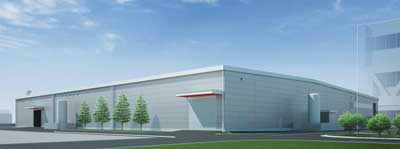Mitsubishi Electric to double satellite component production capacity

With satellite services revenues having increased by 4% globally from 2014 to 2015, reaching US$127.4 billion, powered by continued growth in consumer satellite television, satellite broadband and Earth observation services, Tokyo-headquartered Mitsubishi Electric Corporation says that it has started constructing a facility that will double the satellite-component production capacity of its Kamakura Works, Sagami Factory in Sagamihara, Japan. The factory is Mitsubishi Electric's core production and testing site for solar array panels, structural panels and other satellite components. The new facility, which will commence production in October 2017, is expected to help the company continue growing its share of the global satellite market.
Mitsubishi Electric is one of the world's leading manufacturers of satellite components, structures made with advanced composite materials for the global market, enabling 50% lighter weight compared to steel and more than 30% for aluminium alloys.
The company says it has a rich history of providing global satellite manufacturers with solar array panels, structural panels and antennas produced at its Kamakura Works. Over the years, Mitsubishi Electric has developed a substantial share of this market.
The new facility will introduce a number of advanced manufacturing machines, such as high-precision machining equipment and automated welding machines, which will help the factory to double its production capacity. Existing machines currently dispersed throughout the factory will be concentrated in the new facility. The realisation of seamlessly integrated production processes ─ from component and panel production to final testing ─ and improved productivity through the application of information technology, will further increase production efficiency, shorten production time, reduce costs and elevate product quality, it says.
Mitsubishi Electric says it has participated in the production of more than 500 domestic and international satellites as either the prime contractor or a major subcontractor. In 2000, it became the first Japanese manufacturer capable of developing, designing, assembling and testing satellites at a single location. The company's Kamakura Works is equipped with one of Japan's largest thermal vacuum testing chambers, an acoustic test chamber and an antenna test range. To date, the works has produced 18 satellites, as well as electronic modules for the Japanese-driven H-II Transfer Vehicle (HTV), which is used for automated cargo resupply in outer space.
Mitsubishi Electric strengthened its presence in the global satellite market when it was selected to supply the TURKSAT-4A and TURKSAT-4B satellites to Turkey's Turksat A.S. in March 2011. The two satellites incorporate Mitsubishi Electric's DS2000 satellite platform, which facilitates the delivery of highly reliable satellites at reasonable costs. In May 2011, Mitsubishi Electric successfully delivered its ST-2 communications satellite into geostationary orbit for a joint venture between Singapore Telecommunications Limited and Taiwan-based Chunghwa Telecom Company Limited. In 2014, the company was awarded a contract to deliver the Es'hail 2 communications satellite to operator Qatar Satellite Company (Es'hailSat).
(PRA)Copyright (c) 2016 www.plasticsandrubberasia.com. All rights reserved.












































